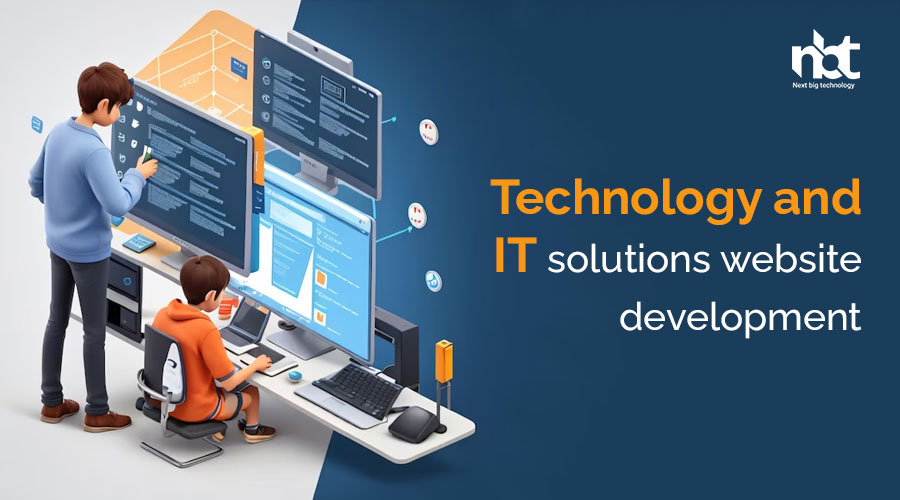Table of Contents
Introduction to Technology and IT Solutions Website Development
In the fast-paced world of technology and information technology (IT) solutions, a digital presence is not just a necessity; it’s a strategic imperative. Your website is often the first point of contact for potential clients, partners, and stakeholders. It serves as your virtual storefront, offering a glimpse into the innovative solutions your company provides.
Technology and IT solutions websites are unique in that they must strike a delicate balance between conveying complex technical information and ensuring an exceptional user experience. Visitors expect not only to learn about your offerings but also to be engaged and impressed. In this introductory section, we’ll explore the key elements that make technology and IT solutions website development both challenging and rewarding.
The Complex Landscape of Technology Solutions
The technology solutions landscape is multifaceted. From cloud computing and cybersecurity to data analytics and software development, companies in this sector offer a diverse array of services and products. Creating a website that effectively communicates the value and capabilities of these solutions while ensuring clarity can be a formidable task.
Furthermore, the technology sector is dynamic, constantly evolving with new developments, products, and trends emerging regularly. Keeping a website up-to-date and reflective of the latest offerings is a perpetual challenge.
The Importance of User Experience
User experience (UX) is paramount in website development, but it’s especially crucial for technology and IT solutions websites. Potential clients and users often come to these websites with specific problems to solve or needs to address. They expect to find information quickly and efficiently. Thus, the website’s design, navigation, and content must cater to these needs.
Moreover, the website must convey a sense of trust and expertise. Technology is an investment, and clients need to have confidence in the providers they choose. A professional and polished website helps build credibility.
Balancing Technical Depth and Accessibility
One of the unique challenges in developing technology solutions websites is balancing technical depth with accessibility. On one hand, you must provide in-depth technical information for users who want to dive into the nitty-gritty details of your offerings. On the other hand, you should cater to users who are looking for a high-level understanding or a quick solution to their problem. Striking this balance is essential.
Marketing and Lead Generation
While technology and IT solutions websites serve as informational hubs, they are also key drivers for marketing and lead generation. They are not static brochures but dynamic tools for attracting potential clients and nurturing leads. Therefore, integrating lead capture forms, chatbots, and other engagement tools is critical.
Security and Privacy
Security and data privacy are paramount for technology solutions providers. These websites often deal with sensitive data, and ensuring the protection of that data is not only an ethical concern but also a legal requirement in many jurisdictions. A breach can have severe consequences, including reputational damage and legal liabilities.
Measuring Success
Website development is an ongoing process, and the success of a technology and IT solutions website should be continuously assessed. Metrics such as website traffic, lead generation, conversion rates, and user engagement are vital indicators. Moreover, user feedback and behavior should inform ongoing improvements and optimizations.
This comprehensive guide will delve into each of these aspects in greater detail, offering insights, best practices, and real-world examples to assist you in creating a technology and IT solutions website that not only meets the demands of your industry but excels in providing value to your clients and stakeholders.
Key Considerations for Technology Website Development
Choosing the appropriate technology stack is a crucial decision in website development. The technology stack includes the programming languages, frameworks, and tools used to build and maintain your website. For technology and IT solutions websites, some key considerations in selecting the right technology stack include:
- Scalability: Ensure that the chosen stack can accommodate your future growth. As your business expands, you may need to handle increased traffic and data.
- Security: Security should be a top priority. Choose tools and frameworks with a strong focus on security, and stay updated with the latest security patches.
- Performance: Optimize for speed and performance. Slow-loading websites can deter visitors. Utilize content delivery networks (CDNs) and caching mechanisms to enhance performance.
- Content Management System (CMS): Decide whether you want to use an existing CMS like WordPress, Drupal, or Joomla, or go for a custom-built solution. The choice may depend on your specific content and functionality requirements.
- Database Management: Select a database management system that can efficiently handle your data. Whether it’s SQL or NoSQL, the choice will depend on your data structure and needs.
- Integration Capabilities: Consider the ease of integrating your website with third-party tools, APIs, and other software solutions that your clients may use.
Budgeting and Resource Allocation
Creating a technology solutions website involves financial and resource planning. Consider the following:
- Development Costs: Calculate the costs associated with web development, including design, coding, and testing. These costs can vary based on your technology stack and the complexity of the project.
- Hosting and Infrastructure: Determine the hosting requirements for your website. Cloud hosting, dedicated servers, or shared hosting have different cost implications. Also, consider domain registration fees.
- Maintenance and Updates: Your website will require ongoing maintenance, including software updates, security patches, and content updates. Budget for these recurring expenses.
- Content Creation: Allocate resources for content creation. This may include hiring copywriters, designers, and multimedia specialists to produce high-quality content.
- Marketing and Promotion: Don’t forget to allocate resources for marketing and promotion. This includes search engine optimization (SEO), pay-per-click advertising, and social media marketing.
- Analytics and Monitoring: Invest in analytics tools to track the performance of your website. This data will inform your future decisions and optimizations.
Budgeting and resource allocation should be realistic and flexible. It’s essential to have a clear financial plan in place to ensure that your technology solutions website project progresses smoothly without unexpected financial hurdles.
Design and User Experience
User-Centered Design
User-centered design (UCD) is a fundamental principle in website development. Your website’s design should prioritize the needs and preferences of the end users. To achieve this, consider the following aspects:
- User Research: Conduct user research to understand the expectations and behaviors of your target audience. This can involve surveys, interviews, and usability testing.
- Information Hierarchy: Organize content in a way that makes it easy for users to find what they’re looking for. Use clear navigation menus, headers, and a logical information hierarchy.
- User-Friendly Navigation: Ensure that visitors can easily navigate your website. Implement intuitive menu structures and search functionality.
- Consistency: Maintain a consistent design throughout the website. This includes using the same color scheme, fonts, and design elements across all pages.
- Mobile Responsiveness: With the increasing use of mobile devices, it’s crucial that your website is responsive and functions well on various screen sizes.
- Accessibility: Ensure that your website is accessible to all users, including those with disabilities. This includes providing alt text for images, clear headings, and keyboard navigation support.
Responsive Web Design
Responsive web design is essential in today’s multi-device world. Your website should adapt to different screen sizes and resolutions, providing an optimal user experience on smartphones, tablets, and desktops. A responsive design not only enhances user satisfaction but also positively affects your SEO rankings, as search engines prioritize mobile-friendly websites.
Navigation and Information Architecture
Effective navigation is critical for user engagement. Clear and intuitive navigation menus help users find the information they need quickly. Consider the following navigation best practices:
- Use descriptive menu labels and avoid jargon.
- Implement a breadcrumb trail for easy backtracking.
- Offer a search bar with auto-suggestions.
- Utilize footer menus for supplementary links.
- Implement call-to-action buttons for important actions like contacting your team or requesting a demo.
Visual Elements and Branding
The visual elements of your website play a significant role in establishing your brand identity and engaging users. Some considerations include:
- Branding: Consistently apply your brand colors, logos, and fonts to create a cohesive visual identity.
- Images and Multimedia: Use high-quality images, videos, and infographics to enhance the visual appeal of your website. Ensure that media files are optimized for fast loading times.
- Typography: Choose legible fonts for easy reading. Typography should be consistent throughout the site.
- Whitespace: Effective use of whitespace can improve readability and make your website feel less cluttered.
- Visual Cues: Implement visual cues like arrows and buttons to guide users toward important elements or actions.
Your website’s design should reflect your brand’s personality and values while ensuring a smooth and pleasant user experience.
Search Engine Optimization (SEO) for IT Websites
Page Load Speed
For IT and technology solutions websites, page load speed is critical. Visitors often expect fast, responsive websites, and search engines favor sites that load quickly. A slow website can lead to a high bounce rate and negatively impact your SEO rankings. To improve page load speed:
- Optimize images and multimedia content to reduce their file sizes.
- Implement browser caching to reduce server load and load times for returning visitors.
- Use Content Delivery Networks (CDNs) to serve content from servers geographically closer to the user.
- Minimize HTTP requests by reducing the number of resources loaded on a page.
Mobile Optimization
With the increasing use of mobile devices, optimizing your technology solutions website for mobile is no longer an option but a necessity. Google’s mobile-first indexing means that your mobile site is the primary version considered for ranking. To ensure mobile optimization:
- Implement a responsive design that adapts to various screen sizes and orientations.
- Test the website’s mobile usability and fix any issues.
- Ensure that buttons and links are easily tappable on small screens.
- Optimize images for mobile devices to reduce data usage and improve load times.
On-Page and Off-Page SEO Strategies
On-page and off-page SEO strategies are fundamental for improving your website’s visibility in search engine results. On-page SEO involves optimizing individual pages on your website, while off-page SEO focuses on external factors that impact your site’s rankings. Key on-page and off-page strategies include:
On-Page SEO:
- Keyword Research: Identify relevant keywords and use them strategically in your content.
- Meta Tags: Optimize meta titles and descriptions with keywords to improve click-through rates from search results.
- Content Quality: Publish high-quality, informative, and original content.
- Internal Linking: Use internal links to guide users to related content on your website.
- Header Tags: Organize content with header tags (H1, H2, H3) for improved readability and SEO.
- XML Sitemaps: Create and submit XML sitemaps to search engines for better crawling and indexing.
Off-Page SEO:
- Backlinks: Build high-quality backlinks from authoritative websites in your industry.
- Social Signals: Engage on social media platforms to promote your content and brand.
- Online Reputation: Monitor and manage your online reputation and respond to reviews and comments.
- Guest Blogging: Contribute valuable content to other websites in your niche, including backlinks to your site.
- Influencer Collaboration: Partner with industry influencers to gain exposure and credibility.
Measuring SEO Success
To gauge the effectiveness of your SEO efforts, it’s crucial to track and measure key performance indicators (KPIs). Some common SEO metrics to monitor include:
- Organic Traffic: Monitor the number of visitors coming from search engines.
- Keyword Rankings: Keep track of your website’s rankings for important keywords.
- Click-Through Rate (CTR): Measure the percentage of users who click on your search result.
- Bounce Rate: Analyze the rate at which visitors leave your site without engaging with content.
- Conversion Rate: Track the percentage of visitors who take desired actions (e.g., filling out a contact form).
Using analytics tools like Google Analytics and Google Search Console, you can gain insights into user behavior, search performance, and the impact of your SEO efforts. Regularly reviewing these metrics and making necessary adjustments to your SEO strategy is essential for long-term success.
By incorporating these SEO strategies into your technology solutions website development, you can increase your online visibility, attract organic traffic, and stay competitive in the digital landscape. SEO is an ongoing process, and continuous optimization is necessary to maintain and improve your website’s search engine rankings.
Case Studies: Successful IT Solutions Websites
1. Amazon Web Services (AWS)
Amazon Web Services (AWS), a subsidiary of Amazon, is a global leader in cloud computing and IT infrastructure services. Their website is a prime example of how an IT solutions website should be designed and structured.
Key Features:
- Simplified Navigation: AWS’s website offers a straightforward navigation menu with clear categories such as Solutions, Products, Pricing, and Resources. This ensures visitors can quickly find what they are looking for.
- Rich Content: They provide a wealth of content, including detailed service descriptions, customer case studies, whitepapers, and documentation. This helps potential customers understand the offerings and their real-world applications.
- Engaging Visuals: The website employs engaging visuals, including product images and architecture diagrams, to simplify complex concepts. They also use videos to explain their services effectively.
- Personalization: AWS customizes content based on a user’s profile and previous interactions, creating a personalized experience for returning visitors.
- CTA (Call to Action): Clear and compelling CTAs lead visitors to explore products, get started, or contact sales, making it easy for potential customers to take the next step.
- Resource Center: AWS’s resource center is a treasure trove of information, featuring webinars, blogs, and customer stories. This resource hub not only educates but also fosters a sense of community among AWS users.
2. IBM Cloud
IBM Cloud is IBM’s cloud computing platform and infrastructure service. Their website is a testament to the importance of a seamless user experience and a robust content strategy.
Key Features:
- Interactive Tools: IBM Cloud’s website offers interactive tools such as the “Build a Solution” feature, which allows users to explore cloud solutions tailored to their specific needs.
- Comprehensive Documentation: Detailed documentation is provided for each service, along with code samples and SDKs, making it easier for developers to integrate IBM Cloud services into their projects.
- Chat Support: Real-time chat support is available, allowing users to get immediate assistance and answers to their questions.
- Clear Pricing Information: IBM Cloud provides transparent and accessible pricing information, helping potential customers understand the costs associated with their services.
- Developer Resources: They offer a dedicated developer section with tutorials, open source projects, and access to developer advocates, fostering a sense of community and support for developers.
3. Salesforce
Salesforce is a global leader in customer relationship management (CRM) solutions. Their website is an excellent example of how a technology solutions website can balance comprehensive information with a user-friendly experience.
Key Features:
- Customer Success Stories: Salesforce prominently features customer success stories and case studies, showcasing real-world applications of their CRM solutions.
- Interactive Product Demos: They offer interactive product demos, allowing potential customers to experience the software’s capabilities firsthand.
- Educational Resources: Salesforce provides a vast array of educational content, including webinars, blogs, and e-books, catering to a wide range of learning preferences.
- Community Forums: A thriving community of users and developers, along with discussion forums, fosters engagement and knowledge sharing.
- Mobile Optimization: With an increasing number of users accessing the web on mobile devices, Salesforce’s website is optimized for a seamless mobile experience.
4. Oracle
Oracle is a multinational technology corporation specializing in database software and cloud infrastructure. Their website demonstrates the importance of conveying authority and trust in the technology solutions sector.
Key Features:
- Authority and Thought Leadership: Oracle’s website positions the company as a thought leader through a dedicated section for research, insights, and trends.
- Clear Solutions Architecture: The website provides comprehensive information on their solutions’ architecture, helping potential customers understand the technical aspects.
- Resource Library: An extensive resource library offers whitepapers, reports, and webinars for in-depth learning.
- Global Reach: Oracle’s website caters to a global audience with language options, ensuring that users from different regions can access relevant content.
- Security and Compliance: The website highlights their commitment to security and compliance, an important aspect in the IT solutions domain, to build trust with potential customers.
These case studies of successful IT solutions websites illustrate the diverse strategies and features used by industry leaders. They serve as valuable sources of inspiration for businesses and organizations looking to develop effective websites for promoting their technology and IT solutions.
Future Trends in IT Website Development
The landscape of website development is ever-evolving, and technology solutions websites are no exception. Staying up-to-date with emerging trends is crucial for maintaining a competitive edge and ensuring your website remains effective. Here are some of the most notable trends in IT website development:
1 AI and Machine Learning Integration
Artificial Intelligence (AI) and Machine Learning (ML) are transforming the way technology solutions websites operate. Chatbots and virtual assistants powered by AI are becoming commonplace for real-time customer support. ML algorithms are used for predictive analytics, personalization, and content recommendation. Integrating AI and ML into your website can enhance user experience and automate certain tasks, such as lead qualification and data analysis.
2 Voice Search Optimization
Voice search is on the rise, thanks to the proliferation of smart speakers and voice-activated assistants like Siri and Alexa. Optimizing your website for voice search involves using conversational keywords and providing concise, direct answers to common user queries. Voice search optimization can significantly improve your website’s visibility and accessibility, especially for mobile users.
3 Progressive Web Apps (PWAs)
Progressive Web Apps are a hybrid between web pages and mobile applications. They offer a fast and engaging user experience, even in low network conditions. PWAs work seamlessly on all devices and platforms, providing an app-like experience without the need for users to download and install anything. Implementing PWAs can enhance user engagement, reduce bounce rates, and improve the overall performance of your technology solutions website.
4 Blockchain Integration
Blockchain technology is not limited to cryptocurrencies. Its decentralized and secure nature is finding applications in various industries, including technology solutions. Incorporating blockchain technology into your website can enhance security, data integrity, and trust. You can use blockchain for secure user authentication, tamper-proof data storage, and even for verifying the authenticity of your technology solutions.
5 Augmented Reality (AR) and Virtual Reality (VR)
AR and VR technologies are gaining traction in showcasing technology solutions. For instance, in the IT services sector, clients can virtually “walk through” data centers or experience software interfaces in a simulated environment. Incorporating AR and VR elements into your website can provide an immersive experience and allow visitors to interact with your solutions in a more tangible way.
6 Cybersecurity and Data Privacy Enhancements
Given the increasing focus on data security and privacy, technology solutions websites must prioritize cybersecurity. The use of HTTPS, regular security audits, and encryption are already standard practices. Implementing multi-factor authentication, advanced threat detection, and privacy-centric design principles can make your website stand out as a trusted and secure resource.
7 Accessibility Compliance
Ensuring your website is accessible to all users, including those with disabilities, is not only a legal requirement in many regions but also a best practice. By adhering to WCAG (Web Content Accessibility Guidelines), you can make your technology solutions website more inclusive, reaching a broader audience and demonstrating your commitment to diversity and inclusivity.
8 Sustainability and Green IT
Sustainability is gaining prominence in the IT sector, with a growing emphasis on “Green IT.” Designing and developing websites with energy-efficient practices and using sustainable hosting solutions not only reduces environmental impact but can also be a selling point for environmentally conscious clients.
9 Data Analytics and Personalization
Data-driven decision-making is a fundamental part of modern business operations. Incorporating advanced data analytics tools into your technology solutions website can help you gather insights into user behavior, preferences, and trends. These insights can be used to personalize the user experience, offer targeted content, and improve conversion rates.
10 Blockchain Integration
Blockchain technology, originally developed for cryptocurrencies, is now finding applications beyond finance. Its decentralized and immutable ledger structure is being used in various industries, including technology solutions. Integrating blockchain technology into your website can enhance data security, build trust with users, and facilitate secure transactions.
Incorporating these emerging trends into your technology solutions website can set you apart from the competition, improve user engagement, and future-proof your online presence. However, it’s important to evaluate each trend’s relevance to your specific business and audience before implementation.






















